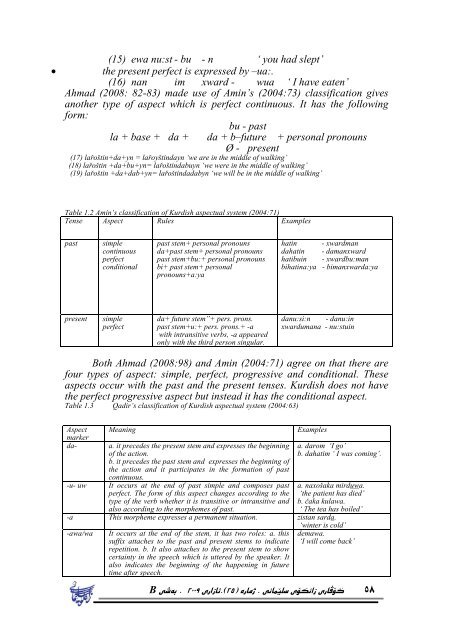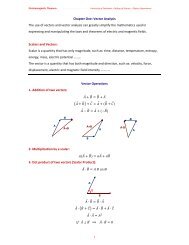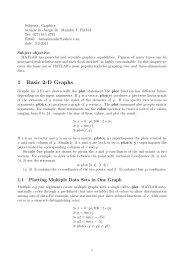Grammatical Aspect in English and Kurdish - University of Sulaimani
Grammatical Aspect in English and Kurdish - University of Sulaimani
Grammatical Aspect in English and Kurdish - University of Sulaimani
Create successful ePaper yourself
Turn your PDF publications into a flip-book with our unique Google optimized e-Paper software.
(15) ewa nu:st - bu - n ‘ you had slept’<br />
the present perfect is expressed by –ua:.<br />
(16) nan im xward - wua ‘ I have eaten’<br />
Ahmad (2008: 82-83) made use <strong>of</strong> Am<strong>in</strong>’s (2004:73) classification gives<br />
another type <strong>of</strong> aspect which is perfect cont<strong>in</strong>uous. It has the follow<strong>in</strong>g<br />
form:<br />
bu - past<br />
la + base + da + da + b–future + personal pronouns<br />
Ø - present<br />
(17) laøošt<strong>in</strong>+da+yn = laøoyšt<strong>in</strong>dayn ‘we are <strong>in</strong> the middle <strong>of</strong> walk<strong>in</strong>g’<br />
(18) laøošt<strong>in</strong> +da+bu+yn= laøošt<strong>in</strong>dabuyn ‘we were <strong>in</strong> the middle <strong>of</strong> walk<strong>in</strong>g’<br />
(19) laøošt<strong>in</strong> +da+dab+yn= laøošt<strong>in</strong>dadabyn ‘we will be <strong>in</strong> the middle <strong>of</strong> walk<strong>in</strong>g’<br />
Table 1.2 Am<strong>in</strong>’s classification <strong>of</strong> <strong>Kurdish</strong> aspectual system (2004:71)<br />
Tense <strong>Aspect</strong> Rules Examples<br />
past<br />
simple<br />
cont<strong>in</strong>uous<br />
perfect<br />
conditional<br />
past stem+ personal pronouns<br />
da+past stem+ personal pronouns<br />
past stem+bu:+ personal pronouns<br />
bi+ past stem+ personal<br />
pronouns+a:ya<br />
hat<strong>in</strong> - xwardman<br />
dahat<strong>in</strong> - damanxward<br />
hatibu<strong>in</strong> - xwardbu:man<br />
bihat<strong>in</strong>a:ya - bimanxwarda:ya<br />
present<br />
simple<br />
perfect<br />
da+ future stem”+ pers. prons.<br />
past stem+u:+ pers. prons.+ -a<br />
with <strong>in</strong>transitive verbs, -a appeared<br />
only with the third person s<strong>in</strong>gular.<br />
danu:si:n - danu:<strong>in</strong><br />
xwardumana - nu:stu<strong>in</strong><br />
Both Ahmad (2008:98) <strong>and</strong> Am<strong>in</strong> (2004:71) agree on that there are<br />
four types <strong>of</strong> aspect: simple, perfect, progressive <strong>and</strong> conditional. These<br />
aspects occur with the past <strong>and</strong> the present tenses. <strong>Kurdish</strong> does not have<br />
the perfect progressive aspect but <strong>in</strong>stead it has the conditional aspect.<br />
Table 1.3 Qadir’s classification <strong>of</strong> <strong>Kurdish</strong> aspectual system (2004:63)<br />
<strong>Aspect</strong><br />
marker<br />
da-<br />
-u- uw<br />
Mean<strong>in</strong>g<br />
a. it precedes the present stem <strong>and</strong> expresses the beg<strong>in</strong>n<strong>in</strong>g<br />
<strong>of</strong> the action.<br />
b. it precedes the past stem <strong>and</strong> expresses the beg<strong>in</strong>n<strong>in</strong>g <strong>of</strong><br />
the action <strong>and</strong> it participates <strong>in</strong> the formation <strong>of</strong> past<br />
cont<strong>in</strong>uous.<br />
It occurs at the end <strong>of</strong> past simple <strong>and</strong> composes past<br />
perfect. The form <strong>of</strong> this aspect changes accord<strong>in</strong>g to the<br />
type <strong>of</strong> the verb whether it is transitive or <strong>in</strong>transitive <strong>and</strong><br />
also accord<strong>in</strong>g to the morphemes <strong>of</strong> past.<br />
Examples<br />
a. darom ‘I go’<br />
b. dahatim ‘ I was com<strong>in</strong>g’.<br />
a. naxošaka mirduwa.<br />
‘the patient has died’<br />
b. èaka kulawa.<br />
‘ The tea has boiled’<br />
-a This morpheme expresses a permanent situation. zistan sarda.<br />
‘w<strong>in</strong>ter is cold’<br />
-awa/wa It occurs at the end <strong>of</strong> the stem, it has two roles: a. this<br />
suffix attaches to the past <strong>and</strong> present stems to <strong>in</strong>dicate<br />
repetition. b. It also attaches to the present stem to show<br />
certa<strong>in</strong>ty <strong>in</strong> the speech which is uttered by the speaker. It<br />
also <strong>in</strong>dicates the beg<strong>in</strong>n<strong>in</strong>g <strong>of</strong> the happen<strong>in</strong>g <strong>in</strong> future<br />
time after speech.<br />
demawa.<br />
‘I will come back’<br />
25<br />
BÑoÐG+/--6Òg?i@Ô+%/2&Ïg@½e+ÑÁ@¾â̺kÒÙÁ?iÒg@¡Ù}

















